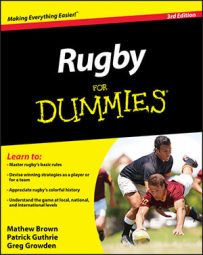Like most sports that didn’t originate in North America, the game of rugby can be difficult to comprehend at first glance because of the large number of players involved, the seemingly random calls of the referee, and the wide variety of strategies employed by different teams to score points and get wins.
The following sections outline who all the players are, explain what the referee is generally looking for during the rugby match, and spell out the basic skills required to be successful on the pitch.
Rugby positions
A rugby team has 15 positions. Each one wears a specific number and has individual responsibilities:
1 and 3 are the props
2 is the hooker
4 and 5 are the locks
6 and 7 are the flankers
8 is, conveniently enough, the eightman
This group is collectively referred to as the pack or the forwards. This group’s main goal is to win possession of the ball. These players are usually the heavyweights of the team, using their bulk and strength to try to overpower their opponents.
A rugby team has another group as well — the backs or back line:
9 is the scrumhalf
10 is the flyhalf
11 and 14 are the wings
12 and 13 are the inside and outside centers
15 is the fullback
To get a feel for what each player is charged with doing on the rugby pitch, see Chapter 4.
Rugby scoring
The aim of rugby is to score more points than the opposition. This is done in four different ways:
Try: The most valuable play is to score a try, which means touching the ball down in the opponent’s in-goal area or on their goal line. Doing so is worth five points and earns that team the right to attempt a conversion kick.
Conversion kick: This kick is worth an additional two points. The conversion kick is taken from a spot in line with where the ball was originally grounded, so scoring as close to the posts as possible is best.
Penalty kick: Penalties for various infractions can be used to take a kick at goal, which is worth three points.
Dropped goal: A dropped goal, which occurs when the player drops the ball on the ground and then kicks it just as it bounces, is worth three points if it goes through the uprights.

